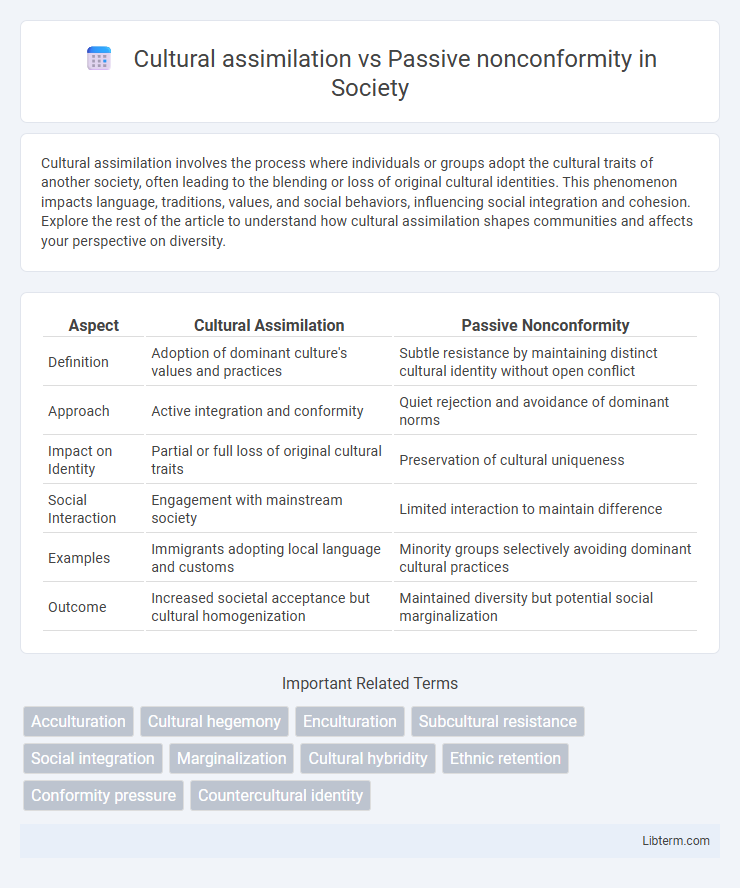Cultural assimilation involves the process where individuals or groups adopt the cultural traits of another society, often leading to the blending or loss of original cultural identities. This phenomenon impacts language, traditions, values, and social behaviors, influencing social integration and cohesion. Explore the rest of the article to understand how cultural assimilation shapes communities and affects your perspective on diversity.
Table of Comparison
| Aspect | Cultural Assimilation | Passive Nonconformity |
|---|---|---|
| Definition | Adoption of dominant culture's values and practices | Subtle resistance by maintaining distinct cultural identity without open conflict |
| Approach | Active integration and conformity | Quiet rejection and avoidance of dominant norms |
| Impact on Identity | Partial or full loss of original cultural traits | Preservation of cultural uniqueness |
| Social Interaction | Engagement with mainstream society | Limited interaction to maintain difference |
| Examples | Immigrants adopting local language and customs | Minority groups selectively avoiding dominant cultural practices |
| Outcome | Increased societal acceptance but cultural homogenization | Maintained diversity but potential social marginalization |
Defining Cultural Assimilation
Cultural assimilation involves the process by which individuals or groups adopt the cultural traits, values, and behaviors of another dominant culture, often leading to the loss of their original identity. This transformation is characterized by integration into societal norms, language acquisition, and acceptance of mainstream customs. Cultural assimilation contrasts sharply with passive nonconformity, where individuals maintain their distinct cultural identity through subtle resistance and non-complicit behaviors without overt confrontation.
Understanding Passive Nonconformity
Passive nonconformity involves subtly resisting dominant cultural norms without overt confrontation, often through maintaining private beliefs or behaviors that differ from mainstream expectations. This contrasts with cultural assimilation, where individuals actively adopt the values, customs, and behaviors of the dominant culture to blend in. Understanding passive nonconformity reveals how marginalized groups preserve identity and agency by quietly rejecting assimilation pressures, fostering resilience without direct conflict.
Historical Contexts of Assimilation
Historical contexts of assimilation reveal contrasting approaches like cultural assimilation, where minority groups adopt dominant social norms to integrate, and passive nonconformity, characterized by subtle resistance and preservation of distinct identities. In colonial and post-colonial settings, cultural assimilation often resulted in loss of indigenous languages and traditions, while passive nonconformity maintained cultural heritage despite external pressures. These dynamics reflect the complexities of identity negotiation within power hierarchies and social integration policies across different historical periods.
Roots of Nonconformist Attitudes
Roots of nonconformist attitudes stem from deep cultural values prioritizing individuality and skepticism toward dominant societal norms, often contrasting sharply with cultural assimilation that emphasizes blending and adapting to mainstream culture. Passive nonconformity manifests as subtle resistance through non-participation or selective engagement rather than overt opposition, reflecting an internal commitment to personal or collective identity preservation. These attitudes are grounded in historical experiences of marginalization, ideological beliefs, and the desire to maintain unique cultural heritage within an assimilative society.
Identity Formation in Diverse Societies
Cultural assimilation involves adopting the dominant society's customs, language, and values, leading to a transformed or blended identity often reflecting mainstream norms. In contrast, passive nonconformity allows individuals to maintain distinct cultural traits while subtly resisting full integration, fostering a layered and multifaceted identity within diverse societies. These processes critically shape identity formation by balancing belonging and individuality amidst multicultural environments.
Social Pressures and Group Dynamics
Cultural assimilation often occurs under intense social pressures where individuals conform to dominant group norms to gain acceptance, reducing cultural differences and promoting uniformity. In contrast, passive nonconformity involves subtle resistance to these pressures by silently maintaining one's cultural identity without overt confrontation, thereby challenging group dynamics while avoiding direct conflict. These contrasting responses shape social cohesion and identity negotiation within multicultural settings, influencing how groups balance inclusion and individuality.
Impact on Minority Communities
Cultural assimilation often leads minority communities to adopt dominant societal norms, resulting in the erosion of unique cultural identities and traditional practices. Passive nonconformity allows these communities to maintain their distinct cultural heritage while subtly resisting pressure to conform, fostering resilience and a sense of self within minority groups. Both responses impact social cohesion, but passive nonconformity can empower minorities to negotiate cultural preservation amid dominant influences.
Benefits and Challenges of Each Approach
Cultural assimilation offers benefits such as enhanced social integration, improved communication, and increased economic opportunities by adopting the dominant culture's norms, yet challenges include the loss of cultural identity and potential psychological stress. Passive nonconformity allows individuals to maintain their cultural heritage and personal values, fostering diversity and self-expression, but may result in social isolation, misunderstandings, and limited access to mainstream resources. Balancing these approaches requires addressing identity preservation while navigating societal acceptance and opportunity structures.
Case Studies Across Cultures
Case studies across cultures reveal that cultural assimilation often involves adopting dominant social norms and languages, as seen in Native American boarding schools where indigenous identities were systematically replaced. In contrast, passive nonconformity emerges through subtle resistance, such as the refusal of certain African diaspora communities to fully embrace colonial languages, preserving ancestral dialects instead. These examples highlight the varied strategies minorities employ to navigate identity within dominant cultural frameworks.
Navigating Identity in a Globalized World
Cultural assimilation involves adopting the dominant culture's values and practices to blend seamlessly into a new society, often leading to loss of original cultural identity. Passive nonconformity, by contrast, is a subtle form of resistance where individuals maintain their cultural distinctiveness while superficially conforming to mainstream norms. Navigating identity in a globalized world requires balancing these approaches to preserve personal heritage while engaging effectively in diverse social and professional environments.
Cultural assimilation Infographic

 libterm.com
libterm.com